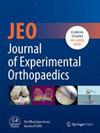Kinematic alignment in Japanese patients shows significant improvement 2 years after total knee replacement surgery
Abstract
Purpose
This study aimed to evaluate the 2-year post-operative results of the unrestricted kinematic alignment technique in total knee arthroplasty (TKA) among Japanese patients and understand the potential benefits of this technique.
Methods
In total, 207 patients who underwent kinematic alignment in TKA for knee osteoarthritis between 2019 and 2021 were retrospectively reviewed. After applying the exclusion criteria, 164 knees remained for analysis (130 and 34 knees from female and male patients, respectively). The average age and body mass index were 74.5 ± 8.0 years and 26.4 ± 4.1 kg/m2, respectively. Radiographic measurements were conducted preoperatively and post-operatively, while clinical evaluations—including knee extension, flexion angles, muscle strength, gait patterns and Knee Society scores (patient satisfaction and function)—were performed preoperatively, 1 year post-operatively and 2 years post-operatively. Statistical analysis was used to determine interobserver reliability and compare the preoperative and post-operative values. Radiographic evaluations were analyzed using a paired Student's t test, while clinical evaluations were analyzed using one-way ANOVA followed by a Tukey–Kramer multiple comparison test. Statistical significance was set at p < 0.05.
Results
After surgery, statistically significant improvements were observed in both knee extension and flexion angles, as well as muscle strength (p < 0.01). Two years after surgery, the rates of independent indoor walking and stair climbing were 89.6% and 58.9%, respectively. Additionally, the Knee Society Scores (patient satisfaction and function) significantly improved compared with the preoperative status (p < 0.01). Complications were minimal; revision surgery was not required.
Conclusion
In Japanese patients, kinematic alignment in TKA demonstrated significant improvements and promising outcomes over 2 years. Although alignment characteristics prior to arthritis may vary due to ethnic differences, this method—designed to replicate patient-specific alignments—is considered to have achieved favourable outcomes by tailoring to individual alignments. Further research comparing kinematic alignment with conventional alignment techniques could provide more valuable insights.
Level of Evidence
Level III.

 求助内容:
求助内容: 应助结果提醒方式:
应助结果提醒方式:


